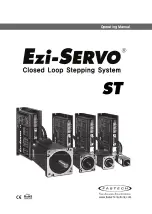
CHAPTER 4 PARAMETER
Control Gain and Filter Setting Parameters
4-23
4
Control mode
No.
PA1_
Name
Default
value
Power
Position
Speed Torque
Record of
reference value
84
Vibration suppressing anti resonance frequency 3
300.0 -
- -
85
Vibration suppressing workpiece inertia ratio
(vibration suppressing resonance frequency) 3
0 -
- -
86
Vibration suppressing damping coefficient
0.0000
-
- -
87
Model torque filter time constant
*** -
-
88
Position loop integration time constant
*** -
- -
89
Position loop integration limiter
0 -
- -
90
Load torque observer
0 -
-
91
P/PI automatic change selection
0 -
-
92
Speed range for friction compensation
10.0 -
-
93
Coulomb friction torque for friction compensation
0 -
-
94
Torque filter setting mode
1 -
-
95
Model torque calculation selection, speed observer
selection
3 -
-
96
Speed limit gain for torque control
*1)
10.0 - - -
*1) The parameter applicable only for VS type
Paremeters marked "
○
" in the table are enabled in the corresponding control mode.
4.3.2 Description of Each Parameter
PA1_51 to 53 Command filter settings
No. Name
Setting
range
Default
value
Change
51 Moving average S-curve time
0, 2 to 500 (×0.125 [ms])
***
Always
52
Low-pass filter (for S-curve) time
constant
0.0 [ms] to 1000.0 [ms]
0.0 Always
53 Command pulse smoothing function 0: Disable 1: Enable
0
Always
Filters can be added to commands for smoother follow-up.
Moving
average
S-curve time
This parameter is enabled under position control.
Specify the moving average S-curve filter time to position commands.
A larger setting at low command pulse frequencies or large electronic gear ratios can
reduce the torque ripple caused by fluctuation of the command pulse.
The new setting of this parameter is reflected when both the position command and
filter accumulation pulse are "0".
If PA1_13 (tuning mode selection) is 0 (auto tuning) or 1 (semi-auto tuning), automatic
adjustment is made inside the amplifier.
Low-pass
filter (for
S-curve)
time constant
Enter the low-pass filter (for S-curve) filter time constant in relation to position
commands and speed commands. Acceleration and deceleration are made so that an
approximate S-curve is drawn.
Summary of Contents for ALPHA 5 RYT-SX
Page 1: ...MEHT301a FUJI SERVO SYSTEM USER S MANUAL RYT SX type ...
Page 19: ...0 1 CHAPTER 0 INTRODUCTION 0 ...
Page 34: ...CHAPTER 0 INTRODUCTION 0 16 Combination between Servomotor and Servo Amplifier 0 ...
Page 35: ...1 1 CHAPTER 1 INSTALLATION 1 ...
Page 45: ...2 1 CHAPTER 2 WIRING 2 ...
Page 142: ...CHAPTER 2 WIRING 2 98 Description of I O Signals 2 ...
Page 143: ...3 1 CHAPTER 3 OPERATION 3 ...
Page 197: ...4 1 CHAPTER 4 PARAMETER 4 ...
Page 296: ...CHAPTER 4 PARAMETER 4 100 Output Terminal Function Setting Parameters 4 ...
Page 297: ...5 1 CHAPTER 5 SERVO ADJUSTMENT 5 ...
Page 329: ...6 1 CHAPTER 6 KEYPAD 6 ...
Page 371: ...7 1 CHAPTER 7 MAINTENANCE AND INSPECTION 7 ...
Page 389: ...8 1 CHAPTER 8 SPECIFICATIONS 8 ...
Page 414: ...CHAPTER 8 SPECIFICATIONS 8 26 Dimensions of Servo Amplifier 8 ...
Page 415: ...9 1 CHAPTER 9 CHARACTERISTICS 9 ...
Page 425: ...10 1 CHAPTER 10 PERIPHERAL EQUIPMENT 10 ...
Page 463: ...11 1 CHAPTER 11 ABSOLUTE POSITION SYSTEM 11 ...
Page 473: ...12 1 CHAPTER 12 POSITIONING DATA 12 ...
Page 482: ...CHAPTER 12 POSITIONING DATA 12 10 Response Time 12 ...
Page 483: ...13 1 CHAPTER 13 PC LOADER 13 ...
Page 513: ...14 1 CHAPTER 14 APPENDIXES 14 ...
Page 545: ...CHAPTER 14 APPENDIXES Service Network 14 33 14 14 8 Service Network ...
Page 546: ...CHAPTER 14 APPENDIXES 14 34 Service Network 14 ...
















































